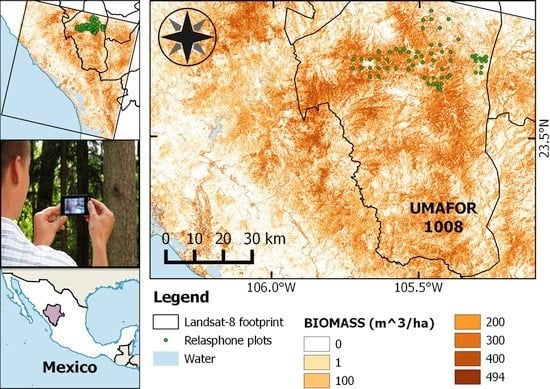Relasphone—Mobile and Participative In Situ Forest Biomass Measurements Supporting Satellite Image Mapping
Abstract
:1. Introduction
2. Study Sites and Datasets
2.1. Boreal Mixed Forest Site in Southern Finland
2.1.1. Study Area and Reference Forest Inventory Plot Data
2.1.2. In Situ Mobile Phone Data Preparation and Acquisition
2.1.3. Satellite Imagery
2.2. Temperate Forest Site in the State of Durango, Mexico
2.2.1. Study Area and Reference Forest Inventory Plot Data
2.2.2. In Situ Relasphone Measurements
2.2.3. Satellite Imagery
3. Methods
3.1. The Relascope Principle
3.2. Application of the Relascope Principle to Digital Cameras
3.3. Relasphone: A Smartphone Application for Forest Basal Area Measurements
- tree diameter;
- site type, characterizing the richness of the soil [55]: herb-rich, mesic, sub-xeric or xeric;
- soil type: mineral or peat;
- development class, characterizing the degree of maturity of the dominant tree species in the plot: young trees (siblings), middle-age trees (thinning), mature trees, open (clear-cuts) or shelter (cleared areas with remaining middle-aged or mature trees for regeneration);
- estimated monetary value of timber.
3.4. Accuracy Assessment
3.5. Combining Relasphone Measurements with Satellite Imagery for Biomass Mapping
4. Results
4.1. Relasphone Biomass Measurements versus Reference Forest Inventory Plot Data
4.2. Satellite Biomass Maps Using Relasphone Observations
5. Discussion
5.1. Quality of Relasphone Measurements
5.1.1. Relasphone Measurements versus Reference Forest Inventory Plot Data
5.1.2. Relasphone Measurements versus Other Forest Mensuration Methods
5.1.3. Quality of Relasphone Measurements as VGI Data and Geo-Location Issues
5.1.4. Considerations on the Quality of Mobile Phone Sensors
5.2. Relevance of the Relasphone for Citizen Science
- Local communities should be involved, from nature enthusiasts to school students. This was not easily feasible in the Mexican study site due to the remote location of the plots and hilly terrain. Forests located closer to large cities or in more accessible terrain can more easily bring locals to take part in such citizen science measurements. In more remote locations, approaches such as geocaching games [73] could be used, targeting nature-enthusiast citizens.
- In Finland, the network of small forest owners has a natural interest in utilizing the application, and private forest owners are often local to their forest of interest during summer.
- Gamification or “serious games” appear to be one of the most efficient ways to engage and attract users for taking part in citizen science projects [74].
5.3. Relevance of the Relasphone for Earth Observation and Forest Biomass Mapping Worldwide
5.4. Applicability of the Relasphone in Tropical Regions
5.5. Future Research and Developments
6. Conclusions
Acknowledgments
Author Contributions
Conflicts of Interest
References
- Sieber, R. Public participation geographic information systems: A literature review and framework. Ann. Assoc. Am. Geogr. 2006, 96, 491–507. [Google Scholar] [CrossRef]
- Goodchild, M.F. Citizens as sensors: The world of volunteered geography. GeoJournal 2007, 69, 211–221. [Google Scholar] [CrossRef]
- Heipke, C. Crowdsourcing geospatial data. ISPRS J. Photogramm. Remote Sens. 2010, 65, 550–557. [Google Scholar] [CrossRef]
- Elwood, S.; Goodchild, M.F.; Sui, D.Z. Researching volunteered geographic information: Spatial data, geographic research, and new social practice. Ann. Assoc. Am. Geogr. 2012, 102, 571–590. [Google Scholar] [CrossRef]
- See, L.; Mooney, P.; Foody, G.; Bastin, L.; Comber, A.; Estima, J.; Fritz, S.; Kerle, N.; Jiang, B.; Laakso, M.; et al. Crowdsourcing, citizen science or volunteered geographic information? The current state of crowdsourced geographic information. ISPRS Int. J. Geo-Inf. 2016, 5, 55–77. [Google Scholar] [CrossRef]
- Silvertown, J. A new dawn for citizen science. Trends Ecol. Evol. 2009, 24, 467–471. [Google Scholar] [CrossRef] [PubMed]
- Estrin, D. Participatory sensing: Applications and architecture. IEEE Int. Comput. 2010, 14, 12–14. [Google Scholar] [CrossRef]
- Khan, W.; Xiang, Y.; Aalsalem, M.; Arshad, Q. Mobile phone sensing systems: A survey. IEEE Commun. Surv. Tutor. 2013, 15, 402–427. [Google Scholar] [CrossRef]
- Dickinson, J.L.; Zuckerberg, B.; Bonter, D.N. Citizen science as an ecological research tool: Challenges and benefits. Ann. Rev. Ecol. Evol. Syst. 2010, 41, 149–172. [Google Scholar]
- Conrad, C.C.; Hilchey, K.G. A review of citizen science and community-based environmental monitoring: issues and opportunities. Environ. Monit. Assess. 2011, 176, 273–291. [Google Scholar] [CrossRef] [PubMed]
- Ferster, C.J.; Coops, N.C. A review of earth observation using mobile personal communication devices. Comput. Geosci. 2013, 51, 339–349. [Google Scholar] [CrossRef]
- Comber, A.; See, L.; Fritz, S.; Van der Velde, M.; Perger, C.; Foody, G. Using control data to determine the reliability of volunteered geographic information about land cover. Int. J. Appl. Earth Obs. Geoinf. 2013, 23, 37–48. [Google Scholar] [CrossRef]
- Fonte, C.; Bastin, L.; See, L.; Foody, G.; Lupia, F. Usability of VGI for validation of land cover maps. Int. J. Geogr. Inf. Sci. 2015, 29, 1269–1291. [Google Scholar] [CrossRef]
- See, L.; Fritz, S.; McCallum, I. Satellite data: Beyond sharing earth observations. Nat. Corresp. 2014, 514, 168. [Google Scholar] [CrossRef] [PubMed]
- Fritz, S.; McCallum, I.; Schill, C.; Perger, C.; Grillmayer, R.; Achard, F.; Kraxner, F.; Obersteiner, M. Geo-Wiki.Org: The use of crowdsourcing to improve global land cover. Remote Sens. 2009, 1, 345–354. [Google Scholar] [CrossRef]
- Fritz, S.; McCallum, I.; Schill, C.; Perger, C.; See, L.; Schepaschenko, D.; Van der Velde, M.; Kraxner, F.; Obersteiner, M. Geo-Wiki: An online platform for improving global land cover. Environ. Model. Softw. 2012, 31, 110–123. [Google Scholar] [CrossRef]
- Schepaschenko, D.; See, L.; Lesiv, M.; McCallum, I.; Fritz, S.; Salk, C.; Moltchanova, E.; Perger, C.; Shchepashchenko, M.; Shvidenko, A.; et al. Development of a global hybrid forest mask through the synergy of remote sensing, crowdsourcing and FAO statistics. Remote Sens. Environ. 2015, 162, 208–220. [Google Scholar] [CrossRef]
- Fisher, R. Tropical forest monitoring, combining satellite and social data, to inform management and livelihood implications: Case studies from Indonesian West Timor. Int. J. Appl. Earth Obs. Geoinf. 2012, 16, 77–84. [Google Scholar] [CrossRef]
- Ferster, C.; Coops, N. Integrating volunteered smartphone data with multispectral remote sensing to estimate forest fuels. Int. J. Digit. Earth 2016, 9, 171–196. [Google Scholar] [CrossRef]
- DeVries, B.; Pratihast, A.K.; Verbesselt, J.; Kooistra, L.; Herold, M. Characterizing forest change using community-based monitoring data and landsat time series. PLoS ONE 2016, 11, 1–25. [Google Scholar] [CrossRef] [PubMed]
- Pratihast, A.; Herold, M.; De Sy, V.; Murdiyarso, D.; Skutsch, M. Linking community-based and national REDD+ monitoring: A review of the potential. Carbon Manag. 2013, 4, 91–104. [Google Scholar] [CrossRef]
- Pratihast, A.; Herold, M.; Avitabile, V.; De Bruin, S.; Bartholomeus, H.; Souza, C., Jr.; Ribbe, L. Mobile devices for community-based REDD+ monitoring: A case study for central vietnam. Sensors 2013, 13, 21–38. [Google Scholar] [CrossRef] [PubMed]
- Pratihast, A.; DeVries, B.; Avitabile, V.; De Bruin, S.; Kooistra, L.; Tekle, M.; Herold, M. Combining satellite data and community-based observations for forest monitoring. Forests 2014, 5, 2464–2489. [Google Scholar] [CrossRef]
- Foody, G.; Boyd, D.S. Using volunteered data in land cover map validation: Mapping west African forests. IEEE J. Sel. Top. Appl. Earth Obs. Remote Sens. 2013, 6, 1305–1312. [Google Scholar] [CrossRef]
- Holck, M.H. Participatory forest monitoring: An assessment of the accuracy of simple cost-effective methods. Biodivers. Conserv. 2008, 17, 2023–2036. [Google Scholar] [CrossRef]
- Food and Agriculture Organization (FAO) of the United Nations. Global Forest Resources Assessment 2015 (FRA 2015): How Are the World’s Forests Changing? 2nd ed.; Food and Agriculture Organization: Rome, Italy, 2016; Available online: http://www.fao.org/3/a-i4793e.pdf (accessed on 25 August 2016).
- Gleason, C.J.; Im, J. A review of remote sensing of forest biomass and biofuel: Options for small-area applications. GISci. Remote Sens. 2011, 48, 141–170. [Google Scholar] [CrossRef]
- Woodcock, C.; Allen, R.; Anderson, M.; Belward, A.; Bindschadler, R.; Cohen, W.; Gao, F.; Goward, S.; Helder, D.; Helmer, E.; et al. Free access to landsat imagery. Science 2008, 320, 1011. [Google Scholar] [CrossRef] [PubMed]
- Penman, J.; Baltuck, M.; Green, C.; Olofsson, P.; Raison, J.; Woodcock, C. Integrating Remote-Sensing and Ground-Based Observations for Estimation of Emissions and Removals of Greenhouse Gases in Forests: Methods and Guidance from the Global Forest Observations Initiative, 1st ed.; Global Forest Observations Initiative (GFOI): Geneva, Switzerland, 2014. [Google Scholar]
- Brown, S.; Gillespie, A.; Lugo, A. Biomass estimation methods for tropical forests with applications to forest inventory data. For. Sci. 1989, 35, 881–902. [Google Scholar]
- Phillips, O.; Malhi, Y.; Higuchi, N.; Laurance, W.; Núñez, P.; Vásquez, R. Changes in the carbon balance of tropical forests: Evidence from long-term plots. Science 1998, 282, 439–442. [Google Scholar] [CrossRef] [PubMed]
- Bitterlich, W. Die Winkelzählprobe. Allg. Forst-und Holzwirt. Zeitung. 1948, 59, 4–5. [Google Scholar] [CrossRef]
- Bitterlich, W. The Relascope Idea: Relative Measurements in Forestry; Commonwealth Agricultural Bureaux: Farnham, UK, 1984. [Google Scholar]
- Clark, N.A.; Wynne, R.H.; Schmoldt, D.L. A Review of past research on dendrometers. For. Sci. 2000, 46, 570–576. [Google Scholar]
- Maas, H.G.; Bienert, A.; Scheller, S.; Keane, E. Automatic forest inventory parameter determination from terrestrial laser scanner data. Int. J. Remote Sens. 2008, 29, 1579–1593. [Google Scholar] [CrossRef]
- Huang, H.; Li, Z.; Gong, P.; Cheng, X.; Clinton, N.; Cao, C.; Ni, W.; Wang, L. Automatic methods for measuring DBH and tree heights with a commercial scanning laser. Photogramm. Eng. Remote Sens. 2011, 77, 219–227. [Google Scholar] [CrossRef]
- Lovell, J.; Jupp, D.; Newnham, G.; Culvenor, D. Measuring tree stem diameters using intensity profiles from ground-based scanning LiDAR from a fixed viewpoint. ISPRS J. Photogramm. Remote Sens. 2011, 66, 46–55. [Google Scholar] [CrossRef]
- Kalliovirta, J.; Laasasenaho, J.; Kangas, A. Evaluation of the laser-relascope. For. Ecol. Manag. 2005, 204, 181–194. [Google Scholar] [CrossRef]
- Strahler, A.H.; Jupp, D.L.B.; Woodcock, C.E.; Schaaf, C.B.; Yao, T.; Zhao, F.; Yang, X.; Lovell, J.; Culvenor, D.; Newnham, G.; et al. Retrieval of forest structural parameters using a ground-based LiDAR instrument (Echidna®). Can. J. Remote Sens. 2008, 34, S426–S440. [Google Scholar] [CrossRef]
- Yao, T.; Yang, X.; Zhao, F.; Wang, Z.; Zhang, Q.; Jupp, D.; Lovell, J.; Culvenor, D.; Newnham, G.; Ni-Meister, W.; et al. Measuring forest structure and biomass in New England forest stands using Echidna ground-based LiDAR. Remote Sens. Environ. 2011, 115, 2965–2974. [Google Scholar] [CrossRef]
- Surový, P.; Yoshimoto, A.; Panagiotidis, D. Accuracy of reconstruction of the tree stem surface using terrestrial close-range photogrammetry. Remote Sens. 2016, 8, 123–135. [Google Scholar] [CrossRef]
- Abd-Elrahman, A.H.; Thornhill, M.E.; Andreu, M.G.; Escobedo, F. A community-based urban forest inventory using online mapping services and consumer-grade digital images. Int. J. Appl. Earth Obs. Geoinf. 2010, 12, 249–260. [Google Scholar] [CrossRef]
- Butt, N.; Slade, E.; Thompson, J.; Malhi, Y.; Riutta, T. Quantifying the sampling error in tree census measurements by volunteers and its effect on carbon stock estimates. Ecol. Appl. 2013, 23, 936–943. [Google Scholar] [CrossRef] [PubMed] [Green Version]
- Häme, T.; Korpela, I.; Hovi, A.; Hippi, I.; Rasinmäki, J.; Molinier, M.; Andersson, K. Social Forest Planning. In Proceddings of Finnish Remote Sensing Days, Espoo, Finland, 4–5 November 2010.
- Molinier, M.; Andersson, K.; Häme, T. Automatic tree stem delineation supporting forest inventory. In Proceedings of the IEEE International Geoscience and Remote Sensing Symposium Vancouver, BC, Canada, 24–29 July 2011; pp. 4465–4468.
- Vastaranta, M.; Latorre, E.G.; Luoma, V.; Saarinen, N.; Holopainen, M.; Hyyppä, J. Evaluation of a smartphone app for forest sample plot measurements. Forests 2015, 6, 1179–1194. [Google Scholar] [CrossRef]
- Molinier, M.; Häme, T.; Toivanen, T.; Andersson, K.; Mutanen, T. Relasphone—Mobile phone and interactive applications to collect ground reference biomass data for satellite image analysis. In Proceedings of the IEEE International Geoscience and Remote Sensing Symposium (IGARSS), Québec, QC, Canada, 13–18 July 2014; pp. 836–839.
- Molinier, M.; Toivanen, T.; Häme, T.; López-Sánchez, C.A.; Corral-Rivas, J.J.; Vega, D. Participative forest in situ measurements for biomass mapping in satellite images over Durango State, Mexico. In Proceedings of the IEEE International Geoscience and Remote Sensing Symposium (IGARSS), Milan, Italy, 26–31 July 2015; pp. 5391–5394.
- Korpela, I.; Heikkinen, V.; Honkavaara, E.; Rohrbach, F.; Tokola, T. Variation and directional anisotropy of reflectance at the crown scale—Implications for tree species classification in digital aerial images. Remote Sens. Environ. 2011, 115, 2062–2074. [Google Scholar] [CrossRef]
- Korpela, I.; Hovi, A.; Morsdorf, F. Understory trees in airborne LiDAR data-Selective mapping due to transmission losses and echo-triggering mechanisms. Remote Sens. Environ. 2012, 119, 92–104. [Google Scholar] [CrossRef]
- Rautiainen, M.; Mõttus, M.; Heiskanen, J.; Akujärvi, A.; Majasalmi, T.; Stenberg, P. Seasonal reflectance dynamics of common understory types in a northern European boreal forest. Remote Sens. Environ. 2011, 115, 3020–3028. [Google Scholar] [CrossRef]
- Korpela, I.; Ørka, H.O.; Maltamo, M.; Tokola, T.; Hyyppä, J. Tree species classification using airborne LiDAR—Effects of stand and tree parameters, downsizing of training set, intensity normalization, and sensor type. Silva Fennica 2010, 44, 319–339. [Google Scholar] [CrossRef]
- Pisek, J.; Rautiainen, M.; Heiskanen, J.; Mõttus, M. Retrieval of seasonal dynamics of forest understory reflectance in a Northern European boreal forest from MODIS BRDF data. Remote Sens. Environ. 2012, 117, 464–468. [Google Scholar] [CrossRef]
- Korpela, I.; Tuomola, T.; Välimäki, E. Mapping forest plots: An efficient method combining photogrammetry and field triangulation. Silva Fennica 2007, 41, 457–469. [Google Scholar] [CrossRef]
- Cajander, A.K. Forest types and their significance. Acta For. Fennica 1949, 56, 1–71. [Google Scholar]
- Næsset, E. Point accuracy of combined pseudorange and carrier phase differential GPS under forest canopy. Can. J. For. Res. 1999, 29, 547–553. [Google Scholar] [CrossRef]
- Valbuena, R.; Mauro, F.; Rodriguez-Solano, R.; Manzanera, J. Accuracy and precision of GPS receivers under forest canopies in a mountainous environment [Exactitud y precisiońn de receptores GPS bajo cubiertas forestales en ambientes montañosos]. Span. J. Agric. Res. 2010, 8, 1047–1057. [Google Scholar] [CrossRef]
- Zandbergen, P.A.; Barbeau, S.J. Positional accuracy of assisted GPS data from high-sensitivity GPS-enabled mobile phones. J. Navig. 2011, 64, 381–399. [Google Scholar] [CrossRef]
- Rahman, H.; Dedieu, G. SMAC: A simplified method for the atmospheric correction of satellite measurements in the solar spectrum. Int. J. Remote Sens. 1994, 15, 123–143. [Google Scholar] [CrossRef]
- López-Serrano, P.; Sánchez, C.; Solís-Moreno, R.; Corral-Rivas, J. Geospatial estimation of above ground forest biomass in the Sierra Madre Occidental in the state of Durango, Mexico. Forests 2016, 7, 70–82. [Google Scholar] [CrossRef]
- Corral-Rivas, J.J.; Vargas, B.; Wehenkel, C.; Aguirre, O.; Álvarez, J.; Rojo, A. Guía para el Establecimiento de Sitios de Inventario Periódico Forestal y de Suelos del Estado de Durango; Facultad de Ciencias Forestales, Universidad Juárez del Estado de Durango: Durango, Mexico, 2009. [Google Scholar]
- Vargas-Larreta, B.; González-Herrera, L.; López-Sánchez, C.; Corral-Rivas, J.; López-Martínez, J.; Aguirre-Calderón, C.G.; Álvarez González, J. Biomass equations and carbon content of the temperate forests of northwestern México. Biomass Bioenerg 2016, in press. [Google Scholar]
- Torres, A.; Lovett, J. Using basal area to estimate aboveground carbon stocks in forests: La Primavera Biosphere’s Reserve, Mexico. Forestry 2013, 86, 267–281. [Google Scholar] [CrossRef]
- Tomppo, E.; Olsson, H.; Ståhl, G.; Nilsson, M.; Hagner, O.; Katila, M. Combining national forest inventory field plots and remote sensing data for forest databases. Remote Sens. Environ. 2008, 112, 1982–1999. [Google Scholar] [CrossRef]
- Häme, T.; Rauste, R.; Antropov, O.; Ahola, H.A.; Kilpi, J. Improved mapping of tropical forests with optical and SAR imagery, Part II: Above ground biomass estimation. IEEE J. Sel. Top. Appl. Earth Obs. Remote Sens. 2013, 6, 92–101. [Google Scholar] [CrossRef]
- Santoro, M.; Beaudoin, A.; Beer, C.; Cartus, O.; Fransson, J.E.; Hall, R.J.; Pathe, C.; Schmullius, C.; Schepaschenko, D.; Shvidenko, A.; et al. Forest growing stock volume of the northern hemisphere: Spatially explicit estimates for 2010 derived from Envisat ASAR. Remote Sens. Environ. 2015, 168, 316–334. [Google Scholar] [CrossRef]
- Häme, T.; Stenberg, P.; Andersson, K.; Rauste, Y.; Kennedy, P.; Folving, S.; Sarkeala, J. AVHRR-based forest proportion map of the Pan-European area. Remote Sens. Environ. 2001, 77, 76–91. [Google Scholar] [CrossRef]
- Foody, G.M.; See, L.; Fritz, S.; Van der Velde, M.; Perger, C.; Schill, C.; Boyd, D.; Comber, A. Accurate attribute mapping from volunteered geographic information: Issues of volunteer quantity and quality. Cartogr. J. 2015, 52, 336–344. [Google Scholar] [CrossRef] [Green Version]
- Flanagin, A.J.; Metzger, M.J. The credibility of volunteered geographic information. GeoJournal 2008, 72, 137–148. [Google Scholar] [CrossRef]
- Foody, G.; See, L.; Fritz, S.; Van der Velde, M.; Perger, C.; Schill, C.; Boyd, D. Assessing the accuracy of volunteered geographic information arising from multiple contributors to an Internet based collaborative project. Trans. GIS 2013, 17, 847–860. [Google Scholar] [CrossRef]
- Goodchild, M.F.; Li, L. Assuring the quality of volunteered geographic information. Spat. Stat. 2012, 1, 110–120. [Google Scholar] [CrossRef]
- See, L.; Comber, A.; Salk, C.; Fritz, S.; Van der Velde, M.; Perger, C.; Schill, C.; McCallum, I.; Kraxner, F.; Obersteiner, M. Comparing the quality of crowdsourced data contributed by expert and non-experts. PLoS ONE 2013, 8, 1–11. [Google Scholar] [CrossRef] [PubMed]
- Clough, G. Geolearners: Location-based informal learning with mobile and social technologies. IEEE Trans. Learn. Technol. 2010, 3, 33–44. [Google Scholar] [CrossRef]
- Salk, C.F.; Sturn, T.; See, L.; Fritz, S.; Perger, C. Assessing quality of volunteer crowdsourcing contributions: lessons from the Cropland Capture game. Int. J. Digit. Earth 2016, 9, 410–426. [Google Scholar] [CrossRef] [Green Version]
- Huy, B.; Poudel, K.P.; Kralicek, K.; Hung, N.D.; Khoa, P.V.; Phuong, V.T.; Temesgen, H. Allometric equations for estimating tree aboveground biomass in tropical dipterocarp forests of vietnam. Forests 2016, 7, 180–198. [Google Scholar] [CrossRef]
- Magnabosco Marra, D.; Higuchi, N.; Trumbore, S.E.; Ribeiro, G.H.P.M.; dos Santos, J.; Carneiro, V.M.C.; Lima, A.J.N.; Chambers, J.Q.; Negrón-Juárez, R.I.; Holzwarth, F.; et al. Predicting biomass of hyperdiverse and structurally complex central Amazonian forests—A virtual approach using extensive field data. Biogeosciences 2016, 13, 1553–1570. [Google Scholar] [CrossRef]
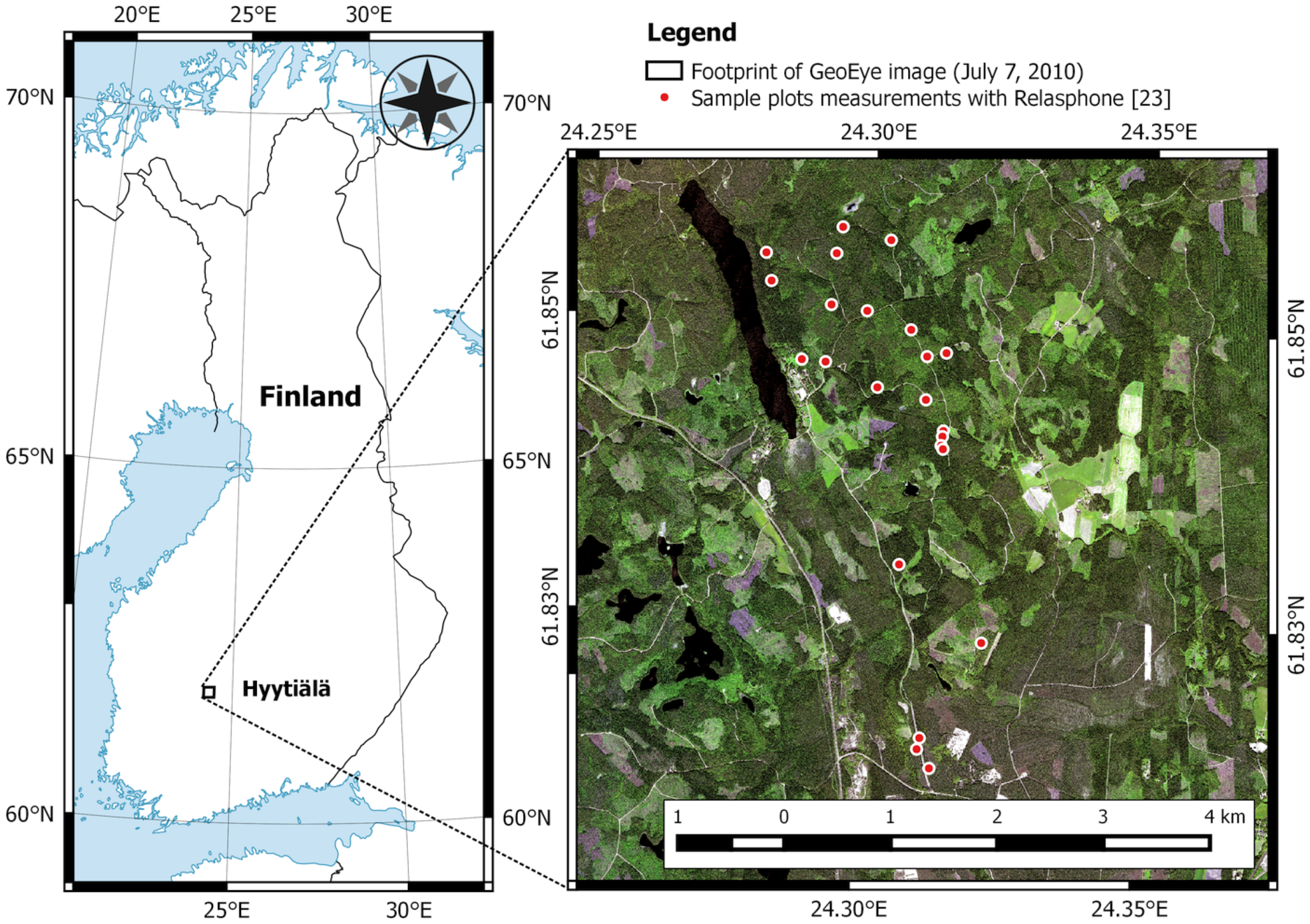

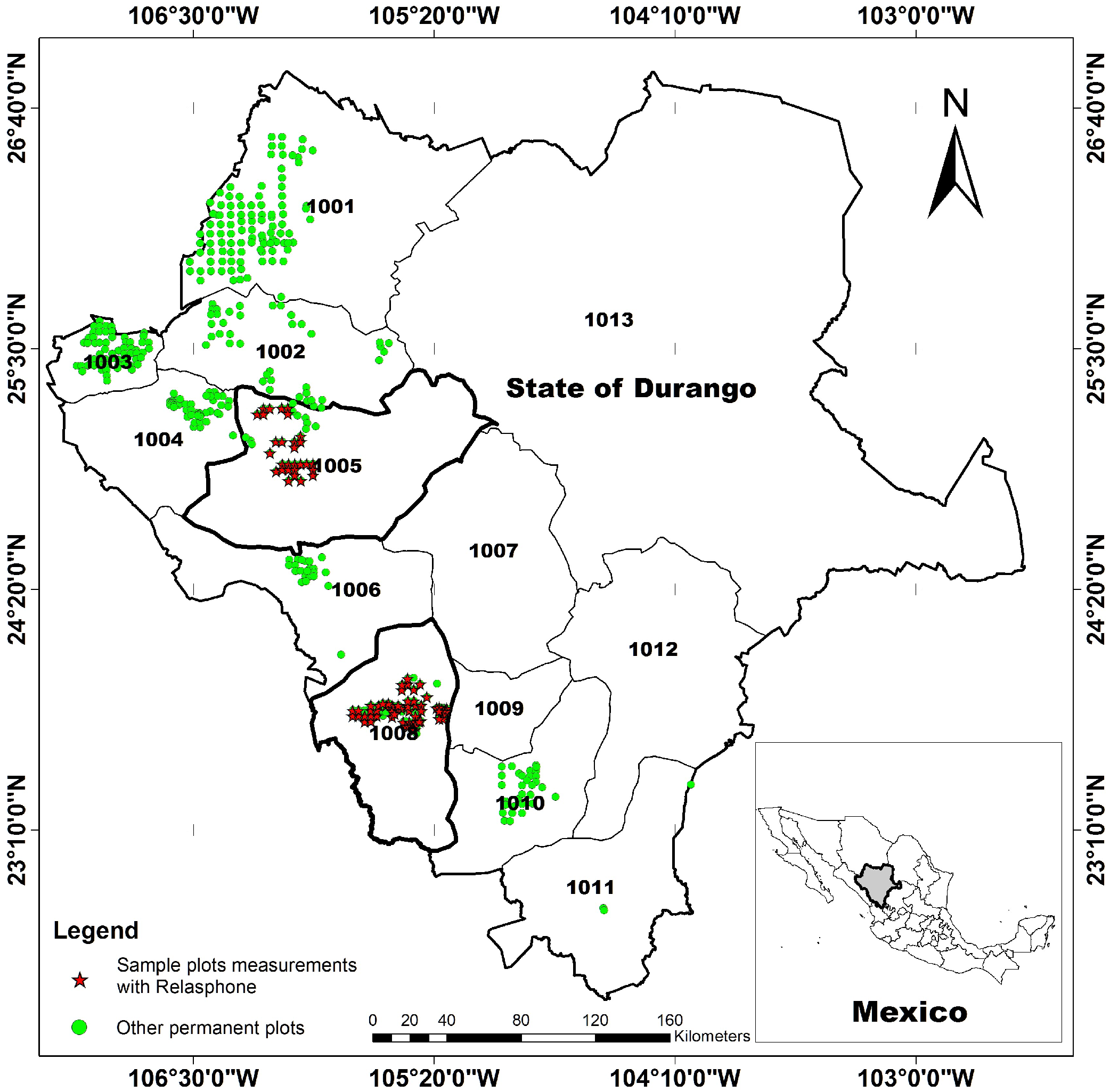


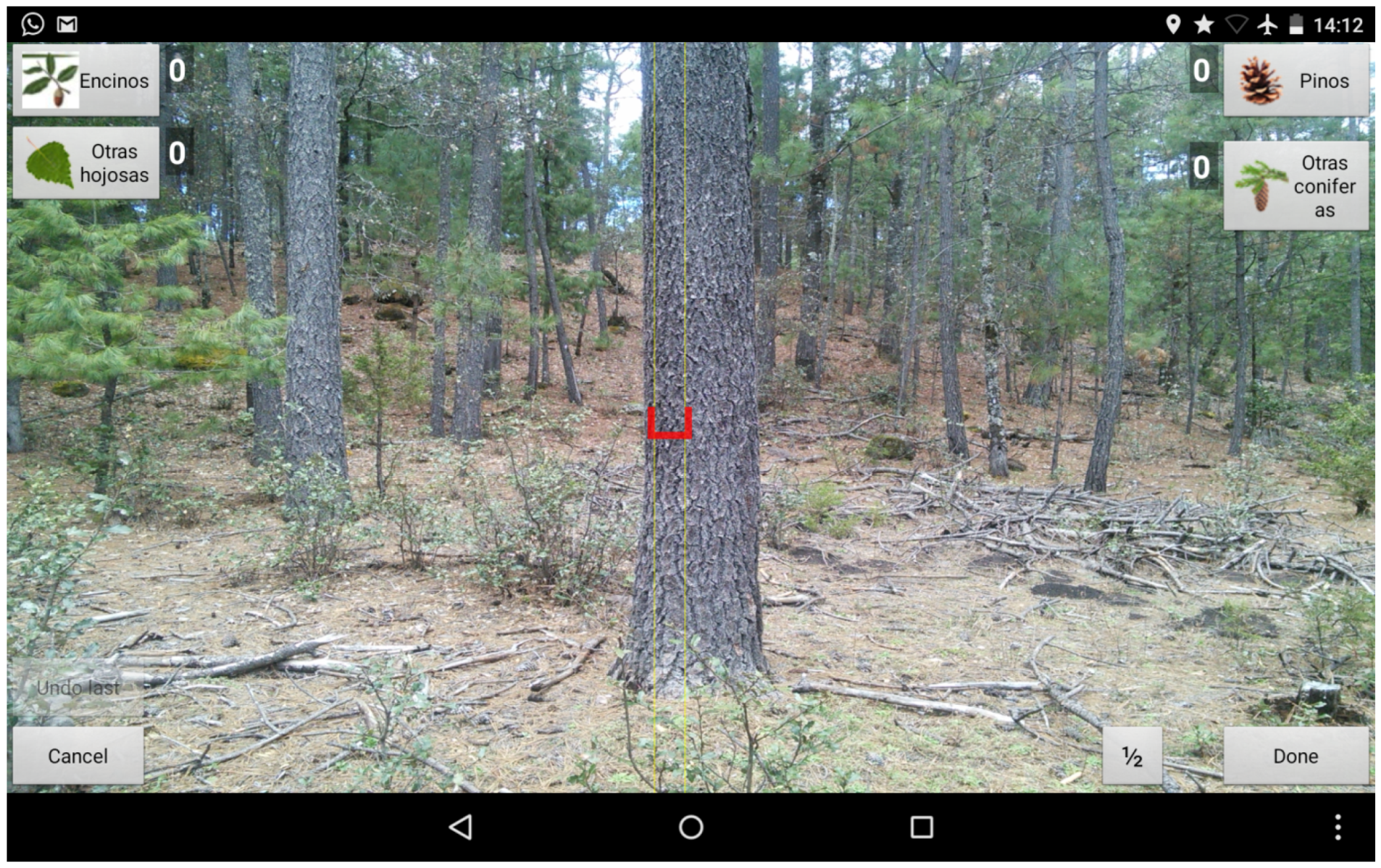
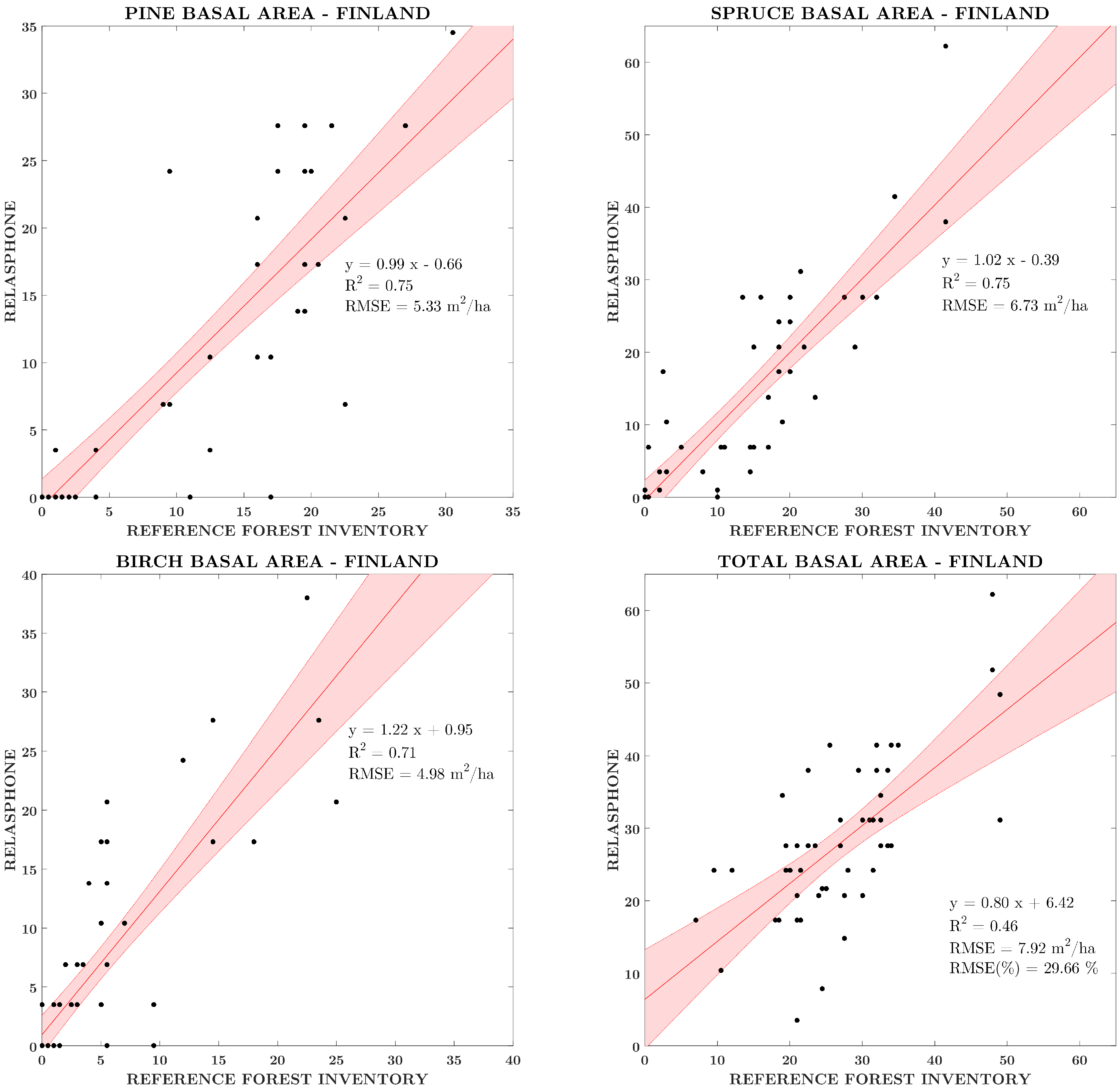
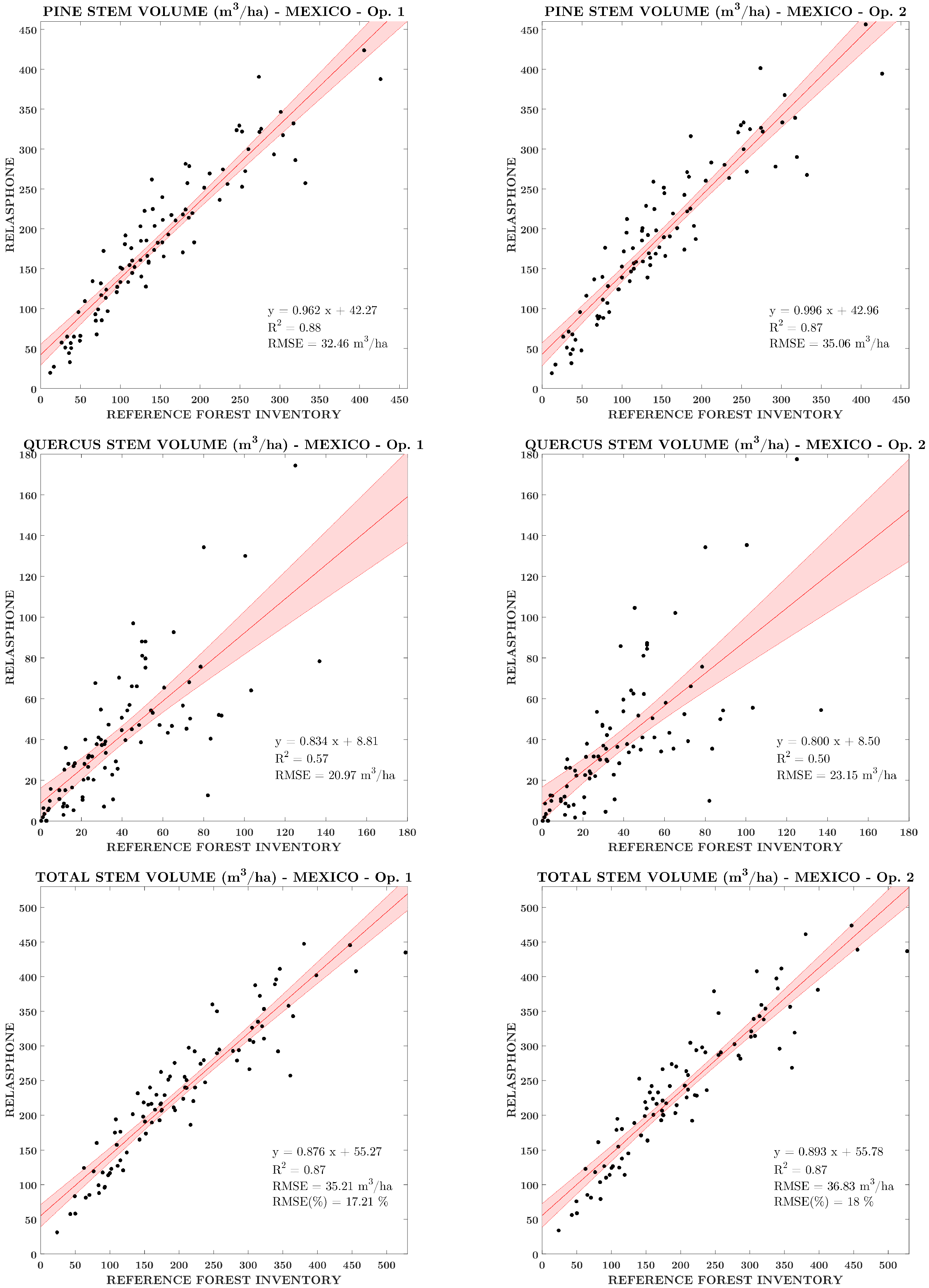
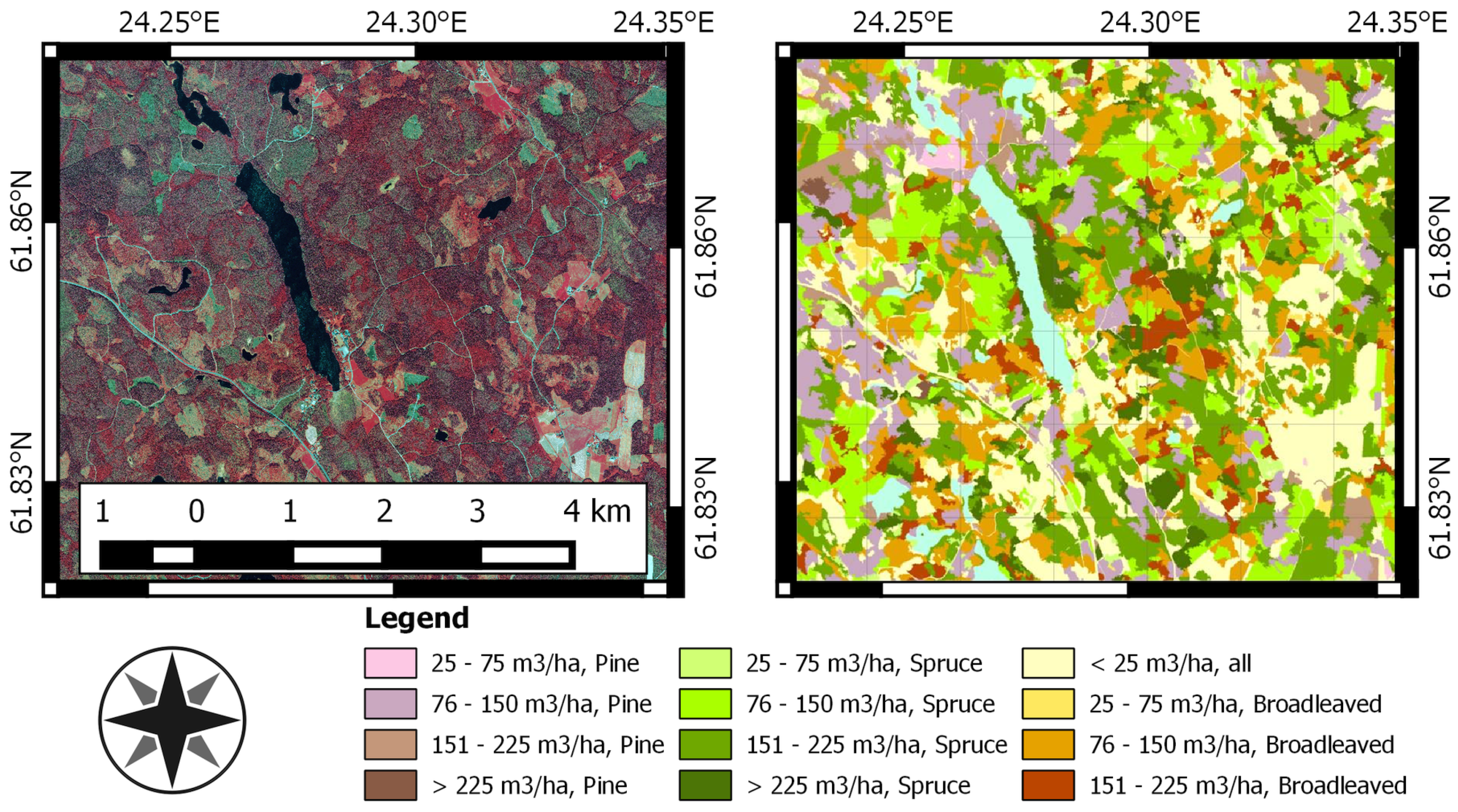

| Variable | Min | Max | Mean | Std |
|---|---|---|---|---|
| Number of stems per ha | 397 | 1931.4 | 980.4 | 462.8 |
| Basal area (m/ha) | 8.6 | 47.9 | 26.1 | 9.8 |
| Plot-wise mean dbh (cm) | 12.3 | 35.3 | 22.7 | 6.3 |
| Plot # | Area | Basal Area (BA) | Mean Diameter, | Pine | Spruce | Birch | OC | OBL |
|---|---|---|---|---|---|---|---|---|
| Number | (m) | (m/ha) | BA-Weighted (cm) | % | % | % | % | % |
| 1 | 1462 | 27.8 | 16.8 | 100 | ||||
| 2 | 1345 | 23.2 | 22.5 | 4.6 | 95.4 | |||
| 3 | 2191 | 21.1 | 27 | 100 | ||||
| 4 | 2092 | 26.2 | 26.1 | 100 | ||||
| 5 | 4010 | 33.6 | 31.3 | 14 | 75.1 | 3.1 | 1.8 | 3.2 |
| 6 | 9501 | 27.8 | 29.7 | 24.3 | 67.7 | 7.7 | 0.4 | |
| 7 | 7259 | 19.3 | 19.1 | 70.7 | 15.1 | 10 | 0.9 | 0.5 |
| 8 | 7730 | 29.6 | 23.2 | 17.7 | 61.1 | 15.7 | 5.1 | |
| 9 | 2576 | 25.4 | 16.2 | 4 | 62.9 | 23.5 | 7.1 | |
| 10 | 6404 | 13 | 21.5 | 48.1 | 3.3 | 48.1 | 0.4 | |
| 11 | 5281 | 26 | 24.6 | 28.4 | 64.9 | 5.5 | 1.2 | |
| 12 | 4510 | 33 | 35.3 | 1.1 | 83.6 | 2.2 | 7.1 | 2.2 |
| 13 | 3368 | 37.1 | 35.2 | 26.2 | 58.9 | 13.9 | ||
| 14 | 2385 | 13.7 | 21.5 | 42.1 | 42.6 | 15.3 | ||
| 15 | 2633 | 14 | 15.2 | 0.7 | 85.6 | 5.2 | 8.6 | |
| 16 | 2245 | 12 | 13.4 | 1.7 | 6.2 | 76 | 16.1 | |
| 17 | 1979 | 22.5 | 16.1 | 62.5 | 29.6 | 8 | ||
| 18 | 2289 | 35.6 | 26.8 | 1.3 | 83.6 | 5.8 | 9.3 | |
| 19 | 2304 | 29.6 | 24.7 | 0.7 | 85.1 | 4.8 | 9.3 | |
| 20 | 2402 | 47.9 | 21.7 | 1.1 | 88 | 8.7 | 2 | |
| 21 | 2380 | 36.6 | 21.7 | 1 | 82.4 | 9.2 | 7.4 | |
| 22 | 2702 | 8.6 | 12.3 | 12.3 | 40.1 | 34.4 | 13.2 | |
| 23 | 3259 | 36.7 | 20.7 | 9.8 | 53.9 | 17.3 | 19 |
| Variable | Min | Max | Mean | Std |
|---|---|---|---|---|
| Number of stems per ha | 224 | 2264 | 645 | 271.84 |
| Diameter at breast height (cm) | 11.69 | 31.12 | 18.44 | 3.46 |
| Dominant height (m) | 6.86 | 30.60 | 17.47 | 5.08 |
| Stand basal area (m/ha) | 8.21 | 54.83 | 23.44 | 8.06 |
| Total stem volume (m/ha) | 23.78 | 527.65 | 204.59 | 104.81 |
| Stand biomass (Mg/ha) | 27.73 | 469.42 | 141.64 | 75.01 |
| Tree Species | (m/ha) | (%) | |||
|---|---|---|---|---|---|
| Hyytiälä, Finland | |||||
| Pine | 0.99 | −0.66 | 0.75 | 5.33 | 59.89 |
| Spruce | 1.02 | −0.39 | 0.75 | 6.73 | 52.99 |
| Birch | 1.22 | 0.95 | 0.71 | 4.98 | 113.18 |
| Total | 0.8 | 6.42 | 0.46 | 7.92 | 29.66 |
| Mean Basal Area (m/ha) | Pine | Spruce | Birch | Total |
|---|---|---|---|---|
| Hyytiälä, Finland | ||||
| Relasphone | 8.2 | 12.6 | 6.3 | 27.8 |
| Reference data | 8.9 | 12.7 | 4.4 | 26.7 |
| (m/ha) | −0.7 | −0.1 | +1.9 | +1.1 |
| (%) | −7.9% | −0.8% | +43.2% | +4.1% |
| Tree Species | Operator 1 | Operator 2 | ||||||
|---|---|---|---|---|---|---|---|---|
| Durango, Mexico | (m/ha) | (m/ha) | ||||||
| Pinus spp. | 0.962 | 42.27 | 0.88 | 32.46 | 0.996 | 42.96 | 0.87 | 35.06 |
| Quercus spp. | 0.834 | 8.81 | 0.57 | 20.97 | 0.8 | 8.5 | 0.5 | 23.15 |
| Other coniferous | 0.944 | 1.89 | 0.34 | 7.07 | 0.871 | 2.08 | 0.35 | 6.46 |
| Other broad-leaved | 0.665 | 2.07 | 0.44 | 4.7 | 0.653 | 1.94 | 0.47 | 4.29 |
| Total | 0.876 | 55.27 | 0.87 | 35.21 | 0.893 | 55.78 | 0.87 | 36.83 |
© 2016 by the authors; licensee MDPI, Basel, Switzerland. This article is an open access article distributed under the terms and conditions of the Creative Commons Attribution (CC-BY) license (http://creativecommons.org/licenses/by/4.0/).
Share and Cite
Molinier, M.; López-Sánchez, C.A.; Toivanen, T.; Korpela, I.; Corral-Rivas, J.J.; Tergujeff, R.; Häme, T. Relasphone—Mobile and Participative In Situ Forest Biomass Measurements Supporting Satellite Image Mapping. Remote Sens. 2016, 8, 869. https://doi.org/10.3390/rs8100869
Molinier M, López-Sánchez CA, Toivanen T, Korpela I, Corral-Rivas JJ, Tergujeff R, Häme T. Relasphone—Mobile and Participative In Situ Forest Biomass Measurements Supporting Satellite Image Mapping. Remote Sensing. 2016; 8(10):869. https://doi.org/10.3390/rs8100869
Chicago/Turabian StyleMolinier, Matthieu, Carlos A. López-Sánchez, Timo Toivanen, Ilkka Korpela, José J. Corral-Rivas, Renne Tergujeff, and Tuomas Häme. 2016. "Relasphone—Mobile and Participative In Situ Forest Biomass Measurements Supporting Satellite Image Mapping" Remote Sensing 8, no. 10: 869. https://doi.org/10.3390/rs8100869
APA StyleMolinier, M., López-Sánchez, C. A., Toivanen, T., Korpela, I., Corral-Rivas, J. J., Tergujeff, R., & Häme, T. (2016). Relasphone—Mobile and Participative In Situ Forest Biomass Measurements Supporting Satellite Image Mapping. Remote Sensing, 8(10), 869. https://doi.org/10.3390/rs8100869







